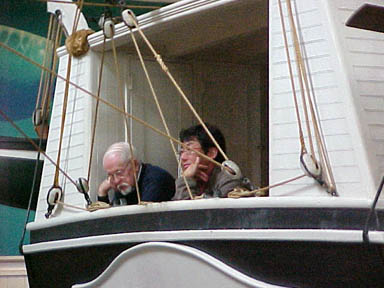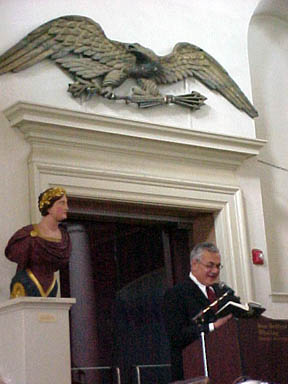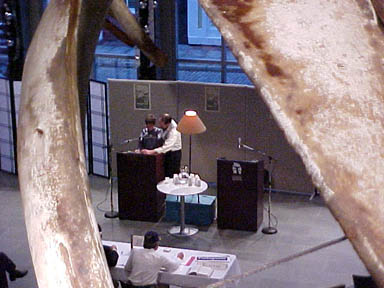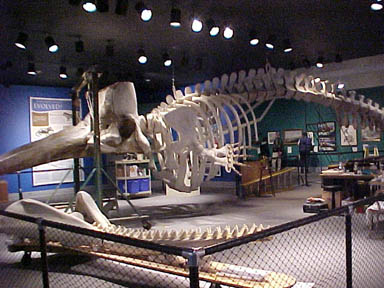 Chapter
8 of Moby Dick begins "In this same New Bedford
there stands a Whaleman's Chapel, and few are the moody
fishermen, shortly bound for the Indian Ocean or Pacific,
who fail to make a Sunday visit to the spot." In the real
21st century New Bedford (as opposed to the slightly
fictionalized 19th century New Bedford) the Seamen's
Bethel still stands on Johnny Cake Hill and still
functions as a house of worship and a memorial to the New
Bedford whalemen and fishermen who have lost their lives
at sea. In this same New Bedford, even in the 21st
century, lives are lost at sea.
Chapter
8 of Moby Dick begins "In this same New Bedford
there stands a Whaleman's Chapel, and few are the moody
fishermen, shortly bound for the Indian Ocean or Pacific,
who fail to make a Sunday visit to the spot." In the real
21st century New Bedford (as opposed to the slightly
fictionalized 19th century New Bedford) the Seamen's
Bethel still stands on Johnny Cake Hill and still
functions as a house of worship and a memorial to the New
Bedford whalemen and fishermen who have lost their lives
at sea. In this same New Bedford, even in the 21st
century, lives are lost at sea.
Before the Captain of the Watch
made it 8 bells and the first reader uttered "Call me
Ishmael" the Executive Director of the New Bedford
Whaling Museum reminded us of both the global catastrophe
of the tsunami in Asia and the more local tragedy of the
loss of the Northern Edge, a New Bedford scallop
boat that capsized in stormy weather off Nantucket just
before Christmas taking the lives of 5 of the 6 crew
members. A memorial service for the Northern Edge
crew was held yesterday at the Seamen's Bethel. Even in
the 21st century, the sea must be taken seriously. This
created a somber atmosphere that gave the start of the
marathon even more of a religious/pilgrimage feel than it
usually has.
 The
reading began in the Lagoda Room. The Bristol County DA,
dressed as a 19th century seaman, started off with "Call
me Ishmael". The mayor of New Bedford and Congressman
Barney Frank, both of whom spoke at yesterday's memorial
service for the Northen Edge crew, read some of
the early chapters full of New Bedford atmosphere. As
usual, the mayor mispronounced Leviathan, but was
otherwise excellent. As usual, Barney was superb. As
usual, the weather was drizzly and gray. At least there
wasn't an ice storm, though icing was predicted for later
tonight. The reading moved to the Seaman's Bethel for the
"Whalemen's Chapel" chapter with the Jonah sermon and
then to the Jacobs Family Gallery (the big room near the
entrance) for most of the afternoon and
evening.
The
reading began in the Lagoda Room. The Bristol County DA,
dressed as a 19th century seaman, started off with "Call
me Ishmael". The mayor of New Bedford and Congressman
Barney Frank, both of whom spoke at yesterday's memorial
service for the Northen Edge crew, read some of
the early chapters full of New Bedford atmosphere. As
usual, the mayor mispronounced Leviathan, but was
otherwise excellent. As usual, Barney was superb. As
usual, the weather was drizzly and gray. At least there
wasn't an ice storm, though icing was predicted for later
tonight. The reading moved to the Seaman's Bethel for the
"Whalemen's Chapel" chapter with the Jonah sermon and
then to the Jacobs Family Gallery (the big room near the
entrance) for most of the afternoon and
evening.
In this same New Beford, the
streets on Johnny Cake Hill are still paved with
cobblestones, the harbor is still jampacked with fishing
boats, cars sport bumperstickers reading "Call Me
Ishmael" or "READ", in the newspaper vending boxes along
the streets the headlines in the Standard-Times are all
about fishing regulations and the Coast Guard
investigation into the sinking of the Northern
Edge. In this same New Bedford, the Java Jungle is
gone. Gone the way of the Java Bean. Don't name your
coffeeshop "Java" anything... It, the Java Jungle that
is, has been replaced by a place called the Greengrocer,
which sells premade soups and sandwiches and coffee from
one of those coffee catering companies like Green
Mountain or New England Coffee Roasters, I forget which
one. The proprietor asked how the reading was going.

Snippets of the marathon
scene:
- someone wearing a t-shirt
reading "What would Queequeg do?",
- a guy carrying a rusty harpoon,
- a man walking down the stairs
with a whale's rib over his shoulder,
- somebody else emerging from the
elevator with a whale vertebrae on a cart
- a Japanese film crew
videotaping one of the Japanese delegation holding the
aforementioned rusty harpoon borrowed from the harpoon
guy
- a rabbi reading in Hebrew with
rhythms usually reserved for the Torah -- he looked
like he'd start davening any minute
- one of the Japanese delegation
reading in English (following the guy who'd read the
same chapter in Japanese) sounding out an unfamiliar
word -- evidently they teach English using phonics in
Japan -- hope that leads to a phonics revival in the
USA
- yes, the faint odor of whale
oil from Kobo's bones
So, Kobo's bones are still oozing
oil, the sperm whale being rearticulated in the gallery
where the panorama used to be is almost all assembled
(and doesn't smell of oil), and the gift shop doesn't
have the gummy orcas this year. There's
special exhibit about
John
Manjiro and the Japan-New
Bedford connection (hence the Japanese delegation to the
reading) with some wonderful scrolls depicting Japanese
and American whaling boats, whales, the sea, and such.
Given my fasicnation with that period (Perry & the
Meiji restoration) I wandered away from the reading to
take in the exhibit. I think I want to go back and savor
it more slowly. There was a lot to absorb. I overheard a
little boy arguing with his sister over whether the
writing on the scrolls was Chinese or Japanese. I told
them they're both right, that the Japanese language is
written with Chinese characters. That blew their little
minds. Come to think of it, it kind of blows my
mind.

Speaking of languages, phonics, and
Manjiro, apparently it was Manjiro who pioneered the
teaching of English "by ear" in Japan. I found
this
article in the Daily Yomiuri.
I guess I was onto something when I noticed that the
Japanese reader was sounding out the unfamiliar English
words. Now if only the mayor could learn to pronounce
Leviathan.
In this same New Bedford, this same
Janet and Nancy, once again discovered that there is
always something new to be found in Moby Dick and
in New Bedford.
 Chapter
8 of Moby Dick begins "In this same New Bedford
there stands a Whaleman's Chapel, and few are the moody
fishermen, shortly bound for the Indian Ocean or Pacific,
who fail to make a Sunday visit to the spot." In the real
21st century New Bedford (as opposed to the slightly
fictionalized 19th century New Bedford) the Seamen's
Bethel still stands on Johnny Cake Hill and still
functions as a house of worship and a memorial to the New
Bedford whalemen and fishermen who have lost their lives
at sea. In this same New Bedford, even in the 21st
century, lives are lost at sea.
Chapter
8 of Moby Dick begins "In this same New Bedford
there stands a Whaleman's Chapel, and few are the moody
fishermen, shortly bound for the Indian Ocean or Pacific,
who fail to make a Sunday visit to the spot." In the real
21st century New Bedford (as opposed to the slightly
fictionalized 19th century New Bedford) the Seamen's
Bethel still stands on Johnny Cake Hill and still
functions as a house of worship and a memorial to the New
Bedford whalemen and fishermen who have lost their lives
at sea. In this same New Bedford, even in the 21st
century, lives are lost at sea.
 The
reading began in the Lagoda Room. The Bristol County DA,
dressed as a 19th century seaman, started off with "Call
me Ishmael". The mayor of New Bedford and Congressman
Barney Frank, both of whom spoke at yesterday's memorial
service for the Northen Edge crew, read some of
the early chapters full of New Bedford atmosphere. As
usual, the mayor mispronounced Leviathan, but was
otherwise excellent. As usual, Barney was superb. As
usual, the weather was drizzly and gray. At least there
wasn't an ice storm, though icing was predicted for later
tonight. The reading moved to the Seaman's Bethel for the
"Whalemen's Chapel" chapter with the Jonah sermon and
then to the Jacobs Family Gallery (the big room near the
entrance) for most of the afternoon and
evening.
The
reading began in the Lagoda Room. The Bristol County DA,
dressed as a 19th century seaman, started off with "Call
me Ishmael". The mayor of New Bedford and Congressman
Barney Frank, both of whom spoke at yesterday's memorial
service for the Northen Edge crew, read some of
the early chapters full of New Bedford atmosphere. As
usual, the mayor mispronounced Leviathan, but was
otherwise excellent. As usual, Barney was superb. As
usual, the weather was drizzly and gray. At least there
wasn't an ice storm, though icing was predicted for later
tonight. The reading moved to the Seaman's Bethel for the
"Whalemen's Chapel" chapter with the Jonah sermon and
then to the Jacobs Family Gallery (the big room near the
entrance) for most of the afternoon and
evening.
